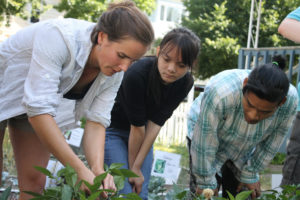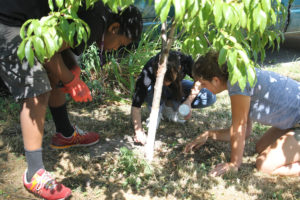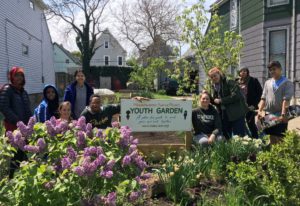Introducing Sustainable Food Production to Buffalo Youth: The Massachusetts Avenue Project
By Claire Collie
For over fourteen years, Massachusetts Avenue Project’s (MAP) Growing Green program on Buffalo’s west side has employed young people, teaching them how to grow food and make positive changes in our local food system. The organization began as a single lot community garden, and has grown to an urban farm spanning 13 lots, with a high tunnel and greenhouse. By next growing season, MAP’s Farmhouse & Community Good Training Center will be complete, housing a commercial kitchen, dry and cold storage, classroom, and office space. This new space will open up opportunities to educate more people on food production and ways we can improve our food system.

A major goal at MAP is to simply show young people what food looks like when it is growing. Farm Education Coordinator Claire and MAP youth employees explore what’s growing. Photo taken by Birch Kinsey.
Produce grown on our urban farm is sold on our mobile market, a small, refrigerated box truck covered in veggie people. Our mobile market travels to neighborhoods in Buffalo that are food deserts – areas where fresh, affordable food is not available. Young people are involved at all steps – from crop production on the farm, to processing and prepping food for market, to the market itself and interacting with customers. Teenagers get to experience as many stages in our local food system as possible, so they become aware of the hard work it takes to produce food crops, the knowledge it takes to feed us, and their ability to make positive change.
We work with a diverse group of young people. Some come from cultures in which maintaining a large kitchen garden in the backyard is common. For others, working on MAP’s urban farm is their first exposure to seeing what food actually looks like before it’s chopped, ground, baked or cooked. So, a major goal is to simply show young people what food looks like when it is growing.
Growing Green participants have their own growing space where they have free reign to choose what to grow, plan where to plant based on a 4-year crop rotation system, maintain the space, and harvest produce. During the winter we discuss what we can grow, and why mangos, oranges and bananas will never be possible to grow in our cold, Buffalo climate. Each year we grow about 50 varieties of crops in this space. The produce grown is used to make weekly lunches for MAP’s community during summer months.

At MAP we allow time for observation and exploration during work. During the summer this means looking for insects and figuring out if they are ‘good bugs’ or ‘bad bugs’ for our crops. Photo taken by Birch Kinsey.
One of the first activities I do with young people new to our program is labeling the crops growing in the youth space. Each teenager is given 6-8 signs labeled ‘tomato’ or ‘carrot.’ Their job is to place the sign in front of the correct plant. Teens are encouraged to taste or smell leaves to help figure out what plant they are looking at. Strawberries, tomatoes and eggplant are quickly identified if they are bearing fruit. Salad greens can be a bit confusing since they are mainly green leaves. But it’s the root crops that are usually unknown and misidentified; Carrots labeled cilantro, radishes marked as lettuce. This may not be surprising, since we rarely see root crops in the market with their stems or leaves. Once all the plant labels have been set in front of a plant, we see if it’s been correctly identified.
The next step is introducing the amount of labor and knowledge it takes to grow our food. We use hand labor and sustainable farming methods to manage our 1.5 acres of land. This means the teenagers who work with us spend a lot of time preparing fields with a broad fork, hand hoes and rakes. They call this the human tractor. Our compost piles are turned over by hand (this task is often cited as a ‘least favorite’). However, when completed, both of these rudimentary tasks offer the satisfaction of a completed job – with sore muscles to prove it.
With time, the teens discover which crops are successful and which don’t work so well in our small growing space. For example, the most requested item to grow is watermelon. In 2015 we dedicated a significant portion of the youth growing space to grow sugar baby watermelons. Throughout the summer we watched with anticipation as fruits grew larger, only to find them smashed on the sidewalk in September. In 2016, we tried again – this time dedicating less space to the vines and growing them up a sturdy trellis. There were no vandals this time, but the fruits were small and not that sweet. After two seasons of disappointment the teenagers were ready to give up on watermelon and focus on crops that would be more successful in our area, and less susceptible to damage.
This year we’re growing lots of salad greens, radishes, carrots, green beans, and 4 kinds of tomatoes. The more exotic plants we’re trying this season are both vines in the cucurbit family: luffa – a gourd used as a sponge in the shower, and bitter melon – a long gourd-like fruit eaten by many Burmese and Thai people in our neighborhood.

MAP’s youth growing space consists of 17 raised beds on one city lot. This year we are growing over fifty crops, including four varieties of radishes. Photo taken by Rebekah Williams.
As an educator, I try to provide the teens tools, materials and knowledge about a task, and then step back and let them learn by doing it. Experimentation with a new tool or getting the feel for the motions of a new task is important for personal development. It also leads to new, creative ideas. For example, last week we were transplanting leeks, a young lady had researched the steps and plant spacing to do this task. I left her and a coworker to start planting. A few minutes later I saw them struggling with step one – dibbling 6 inch deep holes – because the ground was hard and dry to make clean holes to drop leek seedlings into. I watched as they tried digging holes with trowels and pounding their dibbling sticks in with the back of a shovel. Neither of these worked. They left and came back with two watering cans and proceeded to heavily water rows of soil. They figured out not only to soften the soil so they could make deep holes, but also how to keep the rows straight when planting.
I like to allow time for observation and exploration at work. Watching the natural world around us, and seeing interactions between soil and plants, plants and insects, and our manipulations of the environment is key to becoming a farmer. Last summer, during the drought, I had two young women who helped me water everyday. The youth growing space is watered by hand, which means every plant gets individual attention. The girls noticed that the valuable water often flowed away from plant stems and roots, and then would evaporate quickly. So, they started building wells around each plant stem to keep water where it was needed: In turn they mentored other teens why it was important and what they had learned by doing this task.
At every opportunity I try to have teenagers who are more experienced with a task teach those who are newer to growing crops and working outdoors. Passing the role of leader on gives the young people a greater sense of responsibility in the work they are doing. Hopefully, it also instills a deeper understanding into the task. Knowing how to do a task is one thing, but teaching someone else how to do it and why we do it is a path towards mastery.
As I write, we are preparing to welcome a new crop of teenagers to work with us during the summer. Summer is an exciting time of growth for both crops we plant on our farm, and for the young people we work with. This year will be particularly exciting and transformative for our organization as the Farmhouse & Community Good Training Center is constructed on our farm. I look forward to the opportunities this space will give us to work and educate more young people in our community about the power of food and those who grow it.
Claire Collie is the Farm Education Coordinator at the Massachusetts Avenue Project. She can be reached at Claire@mass-ave.org.
For more information about the Massachusetts Avenue Project visit mass-ave.org. To read about working at MAP from Growing Green youth visit here.


i especially liked the reference to a new ‘crop’ of students!